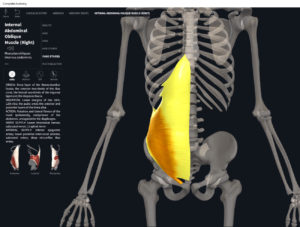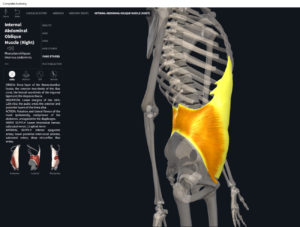Anatomy & Physiology: Muscles—Internal Oblique.
Structure.
- Origin: anterior 2/3 of iliac crest, inguinal ligament, and thoracolumbar fascia.
- Insertion: cartilage of ribs 9-12; linea alba, and contralateral rectus sheaths.
Function.
- Concentric action: spinal bilateral flexion, lateral flexion, and ipsilateral rotation; compress abdomen.
- Reverse mover action: pelvic posterior tilt, lower trunk flexion; ipsilateral pelvic elevation; lateral trunk flexion; contralateral rotation of pelvis, contralateral rotation of lower trunk; compress abdominopelvic cavity.
- Eccentric action: control/restrains/slows spinal extension, lateral flexion, and rotation.
- Isometric action: stabilization of lumbo-pelvic hip complex.
- Innervation: thoracic spinal nerves T8-T12; iliohypogastric nerve; ilioinguinal nerve.
- Arterial supply: subcostal and posterior intercostal arteries, deep circumflex iliac artery, inferior epigastric artery.
Clinical Significance.
More.
References
Biel, A. (2015). Trail guide to the body: A hands-on guide to locating muscles, bones and more.
Cedars-Sinai. (2018). Vertebrae of the spine. Retrieved from https://www.cedars-sinai.org/health-library/diseases-and-conditions/v/vertebrae-of-the-spine.html
Clark, M., Lucett, S., Sutton, B. G., & National Academy of Sports Medicine. (2014). NASM essentials of corrective exercise training. Burlington, MA: Jones & Bartlett Learning.
Jenkins, G., & Tortora, G. J. (2012). Anatomy and Physiology: From Science to Life, 3rd Edition International Stu. John Wiley & Sons.
Muscolino, J. E. (2017). The muscular system manual: The skeletal muscles of the human body.



